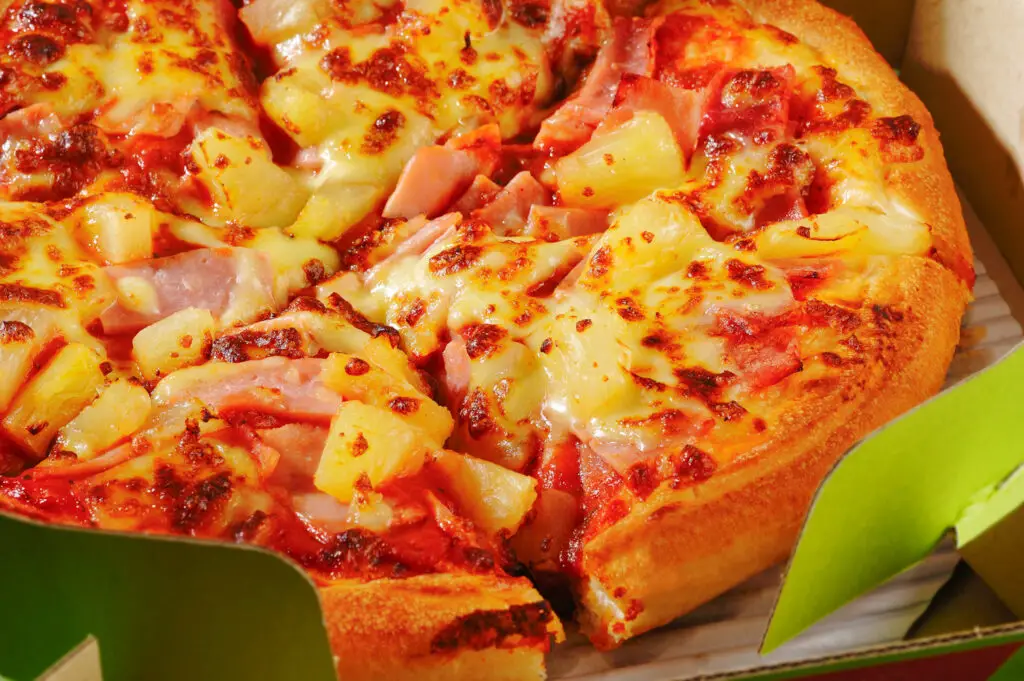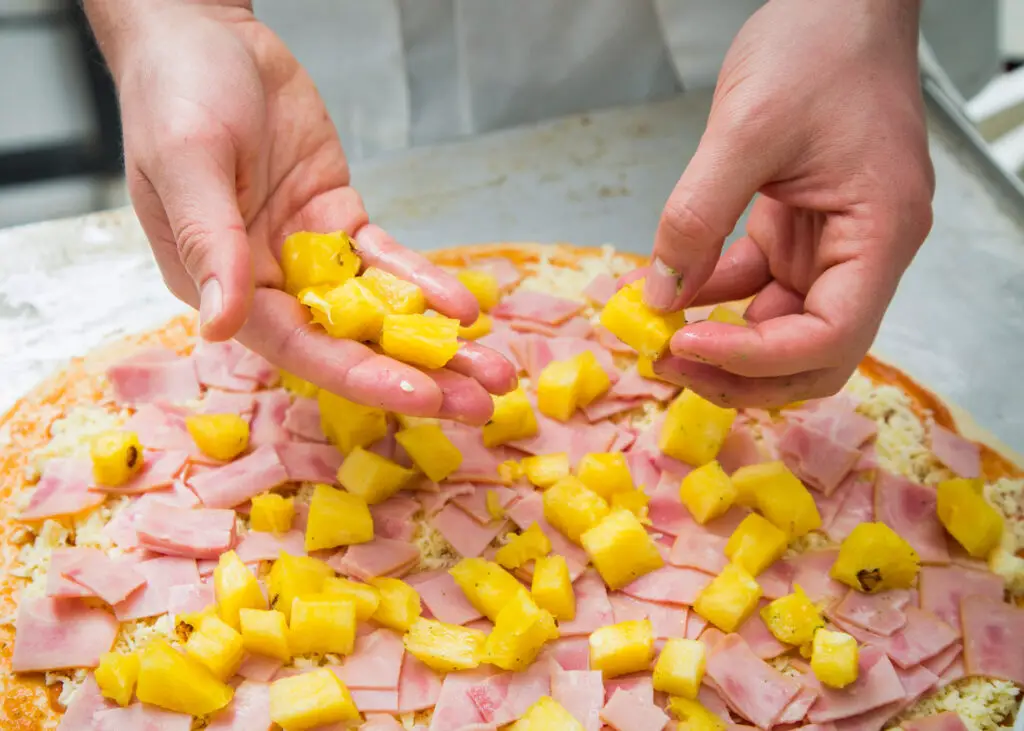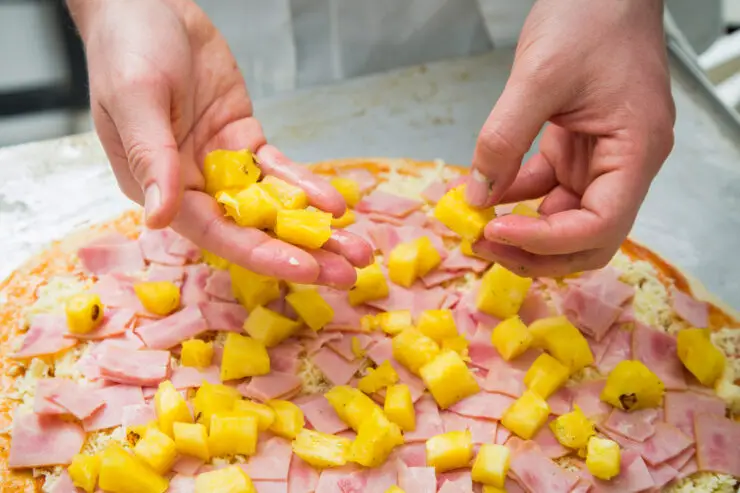As an Amazon Associate I earn from qualifying purchases. Please read the disclaimer for more info.
I’ll be honest: I love pineapple on my pizza. The mix of sweet and salty just works for me. But I know not everyone agrees. Pineapple on pizza is a big debate among food lovers.
Some people say fruit doesn’t belong on pizza, while others, like me, can’t get enough of it.
In this blog post, I’m going to take a closer look at both sides of the argument. So whether you’re a fan of pineapple on pizza or not, stick around. Let’s dig into the pros and cons together.
The pineapple on pizza debate is as juicy as the fruit itself. It splits rooms – some swear by the “Hawaiian” staple while others shun it as a culinary abomination.
How did a simple topping stir such a strong divide?
The pizza debate ignites like wildfire. Passions flare as each side defends their stance. Pineapple as a pizza topping challenges traditional tastes, introducing a tangy sweetness that either disrupts the harmony or adds an exciting twist.
It’s more than just a topping; it’s a statement of how open you are to different flavors and food innovation. Yet, no matter how heated the arguments get, it’s all in the name of good fun and pizza preferences.

Looking for more food related debates? Have you heard of the Perilla Leaf Debate in Korea? Or what about whether or not you can eat starfish?
Origins of Pineapple on Pizza
You might not think a tropical fruit and Italian cuisine would mix, but that’s precisely the story behind pineapple on pizza. It’s a hot topic with a cold history, starting back in the 1960s.
The Birth of Hawaiian Pizza
Believe it or not, the idea of Hawaiian pizza popped up in the snowy reaches of Canada. It wasn’t born in the balmy Pacific, as the name suggests. The unusual pairing of sweet pineapple and savory pizza is said to have come from a bit of playful experimentation.
Key Players:
- Location: Chatham, Ontario, Canada
- Year: 1962
What Happened?
- Experiment: Pizza was topped with canned pineapple for a sweet twist.
- Result: A unique flavor combination that has both charmed and horrified diners worldwide.
Sam Panopoulos, The Greek Immigrant
Sam Panopoulos was the man behind the myth. Your classic Greek immigrant, he made his way to Canada, where he left his indelible mark on global pizza culture. His curiosity and culinary daring gave life to the Hawaiian pizza.
Quick Facts:
- Birthplace: Greece
- Immigration: Moved to Canada in 1954
- Profession: Restaurateur
Sam and his brothers owned the Satellite Restaurant in Chatham, Ontario, where they decided to throw some canned pineapple onto a pizza. His creation has certainly sparked debate, but Sam wasn’t trying to start a food war—he just wanted to try something new.
The name “Hawaiian Pizza” came after the brand of pineapples being used – Hawaiian Pineapples.

The Pineapple Pizza Debate
The Pineapple Pizza Debate stirs up strong feelings from both sides, dividing pizza lovers across the globe. Some can’t get enough of the sweet and savory combo, while others say fruit has no place on a pizza.
Culinary Controversy
The pineapple pizza debate centers around the Hawaiian pizza, a pie that traditionally tops cheese and tomato sauce with ham and pineapple. This particular pizza has become a lightning rod for controversy in the culinary world. Opinions tend to be polarized – you either love the innovative mix of sweet pineapple with the salty ham, or you dislike it, claiming it disrupts the traditional flavors of pizza.
Global Opinions
The debate isn’t confined to one region; it’s a global conversation:
- EU: Doesn’t typically see pineapple pizza as a traditional choice, but variations exist in different countries.
- Canada: Often credited with the creation of Hawaiian pizza, they’ve embraced this topping combo.
- Iceland: Their president, Guðni Thorlacius Jóhannesson, caused a stir on Twitter when he jokingly suggested banning pineapple on pizzas.
- PH (Philippines): Pineapple pizza enjoys popularity, blending the local love for sweet profiles with traditional pizza.
Let’s look at the opinions of a few prominent figures:
Justin Trudeau: Pro-Pineapple. Affirmed his support for pineapple on pizza, declaring it a tasty Canadian invention.
Guðni Thorlacius Jóhannesson: Anti-Pineapple. He clarified that he doesn’t have the power to ban pineapple after his comments caught fire on Twitter.
You’ll see heated discussions on social media platforms like Twitter, where users from various regions jump in to share their love or distaste for this tropical topping. Despite the divide, whether or not to eat pineapple pizza has cemented its place in the global pizza repertoire, secured its slice of popularity, and continues to spark culinary conversations everywhere.

Cultural Impact and Social Media
The debate over this divisive fruit stretches beyond taste buds; it’s a cultural phenomenon that’s taken social media by storm, spurring interactions between you, public figures, and the masses.
Memes and Social Influence
Your online experience is often peppered with the good-humored warfare of pineapple-on-pizza memes. These humorous images and videos regularly circulate on platforms like Twitter and Instagram, sparking laughter and fiery dialogue in the comments section. Memes serve as a barometer for public opinion, with some surveys even drawing conclusions from the number of shares and likes these post garner. For instance:
- Pro-Pineapple Meme: Features a slice of pizza with pineapple, often captioned with playful provocations like “Improve every movie title by adding pineapple on pizza.”
- Anti-Pineapple Meme: Showcases a slice sans pineapple, perhaps with a red cross over the fruit, reinforcing the view against the combination.
Public Figures and Celebrities
The social media profiles of celebrities and chefs are influential battlefields for this culinary dispute. When someone like Justin Trudeau, the Prime Minister of Canada, tweets in favor of pineapple on pizza, the resulting engagement includes thousands of retweets and a wave of free pizza promotions from companies jumping on the bandwagon. For example:
- Justin Trudeau’s Tweet: “I have a pineapple. I have a pizza. And I stand behind this delicious Southwestern Ontario creation. #TeamPineapple”
Chefs also weigh in; their endorsements or rejections influence your dining choices, sometimes through a highlighted poll or survey in their Instagram stories that lets you cast your vote. Boldfaced names like Gordon Ramsay have been known to cause a stir with their stern stance on the matter, making headlines and sometimes even sparking new meme creation.
So, as you scroll through your feed, remember every retweet, every poll vote, and every meme you engage with is a part of the larger conversation that’s making food history, one slice at a time.
Pineapple on Pizza: Taste and Preferences
When you bite into a pineapple-topped pizza, you’re diving into a unique combination of flavors and textures that either entice or repel differing taste buds.
Flavor Profile
Fresh pineapple brings a bold, sweet flavor to the traditionally savory pizza. Its inherent acidity can cut through the richness of cheese and meats like bacon and ham, creating a sweet and savory dance on your palate. It’s not just about the pineapple; how it interacts with other toppings makes or breaks the experience for many. For instance, pair it with ham and have the classic Hawaiian pizza, or toss in some mushrooms for an earthy contrast.
- Sweet: Pineapple’s sugary notes
- Savory: Meats like ham and bacon
- Acidic: Pineapple’s tangy kick
Texture and Toppings
The texture is another crucial aspect of your experience with pineapple on pizza. Pineapple’s juiciness can be a delightful surprise or a soggy setback. It contrasts with the crispness of a well-cooked crust and the gooeyness of melted cheese. Pizza toppings also play a considerable role; bacon adds crunch, while sausage or pepperoni introduces a chewier texture.
- Crisp: Bacon, freshly-baked crust
- Chewy: Sausage, pepperoni
- Juicy: Bite-sized pineapple chunks
My Favorite Toppings
To settle the debate for me, my favorite way to enjoy a pineapple and ham pizza is to combine the following pizza toppings and assemble them like this:
Spread the tomato paste over the base, making sure to leave a border around the edges. Add a layer of mozzarella cheese. Arrange the cooked ham, pineapple chunks, and other salty pizza ingredients, such as anchovies and olives, evenly over the cheese. Sprinkle with chili flakes.
Am I wrong? Let me know in the comments. Bon Appetite!
Did you enjoy this post? If so, you might like one of these:

